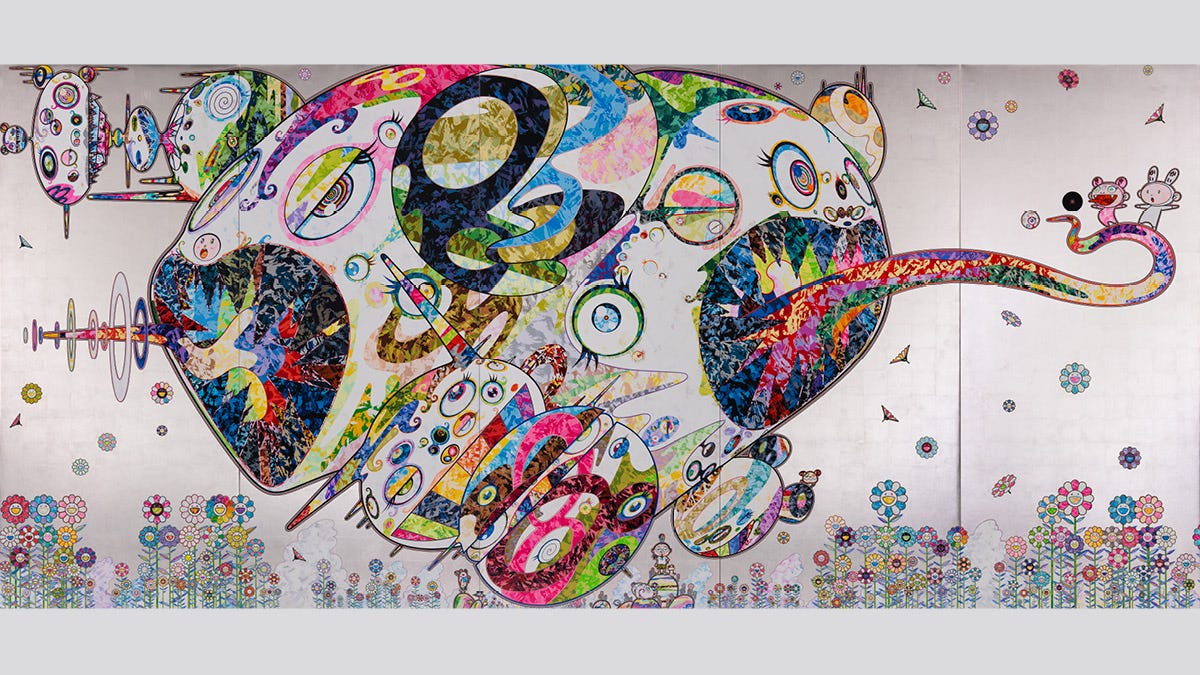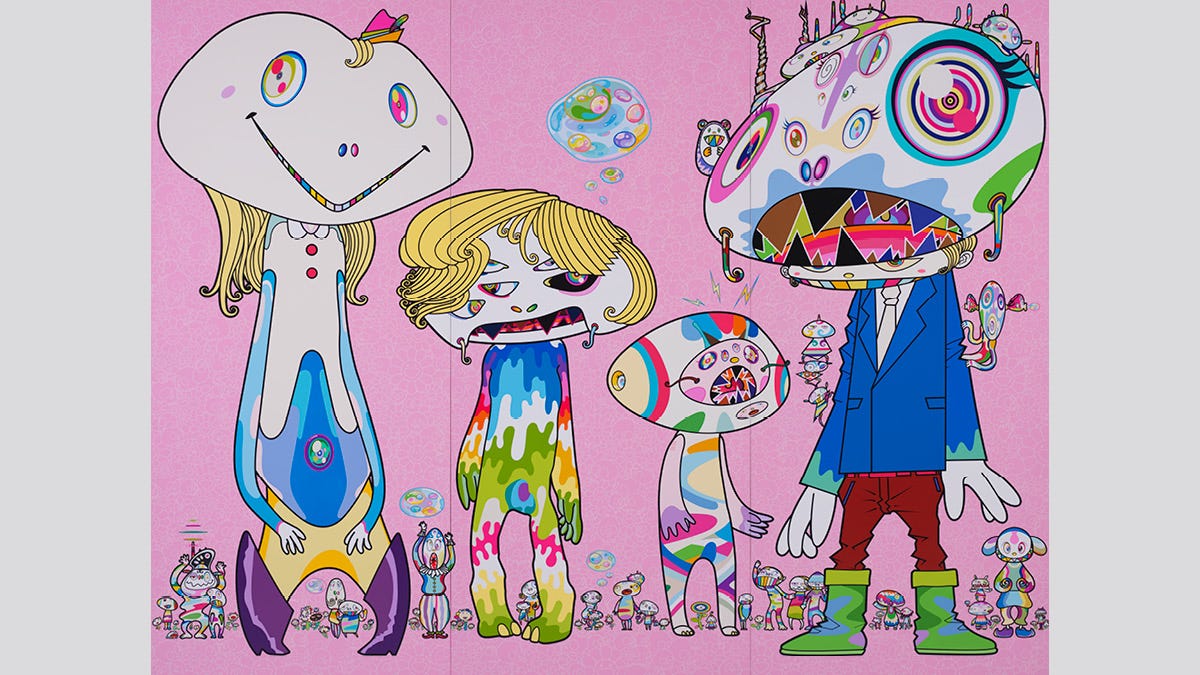Unfamiliar People — Swelling of Monsterized Human Ego: Takashi Murakami at Asian Art Museum
Takashi Murakami is the id of consumer culture in a globalized East-meets-West society.
I trotted into the Asian Art Museum wet and disheveled on another rainy San Francisco afternoon. The Asian Art Museum is located downtown among many cement-laiden government buildings, homeless encampments, and traffic. Lucky for me, simply walking into “Murakami: Monsterized” quickly flipped my horizons as his joyous and multi-hued artworks gave my brain a much needed dopamine hit.
Coming into this exhibition, I already had some preconceived thoughts and feelings about Murakami. After all, he's been everywhere for a long time now! This was not my first time seeing his work. Murakami seems to be more machine than man, an unstoppable force of creation that is so prolific his artwork ranges in multiple mediums, huge sizes (his murals are 82 feet wide) and collaborates with several major brands. Generally speaking, his work has always been enjoyable to me, but I can never help but feel suspicious that it's a little too cutesy to take seriously. Much like a brand, cartoon, or the latest Marvel movie, it clearly relies on the labor of many others. Murakami feels to me much like a corporation, though because of its cuteness, not necessarily an evil one, more like Hello Kitty or Pikachu.
“Monsterized Unfamiliar People - Swelling of Monsterized Human Ego” initially dislodged my preconceived notions of Murakami with its originality and imaginative mural sized paintings. The first two pieces upon entering the exhibition “Bacon: Scream” and “Tan Tan Bo Black Hole” blew me away. The subconscious mishmash of Asian history, anime, and swirling linework in the form of an erupting monster vomiting colorful ice cream was a shock that, at first, made me feel as though Murakami was aware of the endless ugly regurgitation that consumerist culture eventually makes of itself. These pieces were original and unexpected. It felt as though Murakami had thrown his whole identity and corporation into a blender and poured the results on canvas. I was impressed.
There were more pieces that completely floored me as I continued on. A piece entitled “The 11th Dimension” was brilliant in many ways. Murakami deftly gets away with making his rainbow color palette feel suggestive of the dark secrets of the universe by backdropping it with lots of black and cleverly unbalancing the composition in a way that gives the piece an eerie sense of simultaneous weight and weightlessness. Before today I never thought of Murakami as a painter who could wield his style and stand next to other brilliant modern abstract painters like Gerhard Richter or Trudy Benson, but I have now seen the light.
I was also very delighted by the many creature sculptures he had behind glass. Each little cutesy monster seemed to have its own personality yet up close you could see textures like scales and hair, giving me the enjoyment of the Disney Minions vibe with the mischievousness and potential danger of the creatures from the movie Gremlins.
Next was the gigantic mural “Judgement Day” in the main room of the exhibition. The term Maximalist was already tied to Murakami in my mind but this one truly takes the cake. Every inch of this behemoth mural was covered in some sort of texture, character or pattern. I found myself overwhelmed by it very quickly and found myself turning more towards the paintings on the opposite wall, for a visual break. These were, of course, his “Isle of the Dead” pieces, featuring many individualized monks getting smaller and smaller as they traveled down the canvas. These aging ascetics felt like Murakami’s version of the Russian doll. The overwhelming multiples of Buddhist Monks made me postulate that Murakami might be aware of the endless mutation of one meme to another under capitalism. Up close each figure was different, but when you stepped back it all read the same.

This, unfortunately, was about where I stopped finding things I liked. It was… just too much. Murakami’s maximalism was initially refreshing, like the first cool winds of an autumn day, but it was quickly turning into a hurricane. I really tried to look at the mural again but realized there was no way I could ever really see the whole thing. Consuming it would have required more than one person (or coyote) could stomach and I stopped seeing the point in trying to take it in.
I thought that maybe this overwhelming Jupiter-sized storm of color and line was meant to illustrate the monstrousness of capitalism and consumer culture, and hoped to find work that would underscore this point, but I just didn’t see it. While the “Quinghua: Grass Carp, Chinese Perch, and Lotus Flower” pieces were nice, I was already too visually hungover to appreciate them. The NFT room didn’t help either. On display were over 100 paintings of flower icons that were all basically the same. While I understand Murakami wanting to dabble in the new medium, each painting only reminded me of the blandness of tech culture. Murakami just kept regurgitating the same icon, albeit slightly different, over and over again. It was like “Oh cool! a flower with sunglasses on,... oh! Now in this one he has a little hat, .. oh,... now he has a little pipe or cool t-shirt?” over and over again.
The rest of the show left me feeling more empty, and while I normally get some weird looks being a coyote in a public place for humans, everyone was too distracted posing for Instagram in front of kitschy murals to notice. I probably could have walked out with a Murakami painting of my own and no one would be the wiser.
Finding myself in the final room, bored with, yet again, evermore portraits of cartoon characters with silly hairdos, I was asking myself what the point was when something really struck me. At the end of the exhibition is a medium sized painting of a smokey skull and bones on a pink background. It didn’t immediately catch my attention and required me to get up close to realize that in its eyes were tiny flowers stitched in a clockwise rotation. This last painting made me stop and think for a moment about the exhibition as a whole…
To be fair Murakami does know what to do with empty space. Not everything is a homogenous blast of maximalist mayhem. His fish paintings were thoughtful, though I was too blitzed by the time to care much, and a lot can be said about the strength of his linework all across the board. While I understand Murakami’s pink skulls are supposed to represent the negative elements of life in postwar Japan, in the context of this show it felt like something different to me. Perhaps the mind of someone who can’t stop creating, who fills every little gap that they can, when they can, is doing so compulsively to avoid something. Murakami even seems to be self aware of how hard he works. In the description of “Tan Tan Bo Black Hole” it states that Murakami painted this subject during a low point in his life were he was “Subsisting on ramen, cigarettes, and insufficient sleep… he developed gout, a medical condition that left him writhing in agony”
I’m no psychotherapist and it would be unfair of me to diagnose Takashi Murakami with Thanatophobia but the pink skull really got me thinking that under all this consumerism, under all this needless stuff and hyperinflation of the ego, lies a fear of death. Perhaps unconsciously Murakami wants us to see that at the core of the over-consumption of all the sparkling energy of our capitalist and virtual-reality obsessed culture, lies an insecurity, an ego that profoundly fears being dissolved into nothingness.
Walking back through the exhibition this thesis seemed to back itself up with some of the more seminal works. Paintings exploring the superego, black holes, and alternate dimensions, as well as sculptures with little details of wrinkles and white hair, allowed me to see beyond the rainbow-colored consumerist urge to the reality behind our need to feel stimulated, entertained and distracted….
Armchair psychology aside, I walked away ultimately feeling like I enjoyed more of Murakami’s work than I was disgusted. Many of his large paintings and sculptures were more unexpected and original than I would have expected from an artist at a later point in their career. Takashi Murakami’s exhibition at the Asian Art Museum is definitely worth seeing, just be willing to look past the glitter and understand the grit that's within and underneath.
Three Stars.




